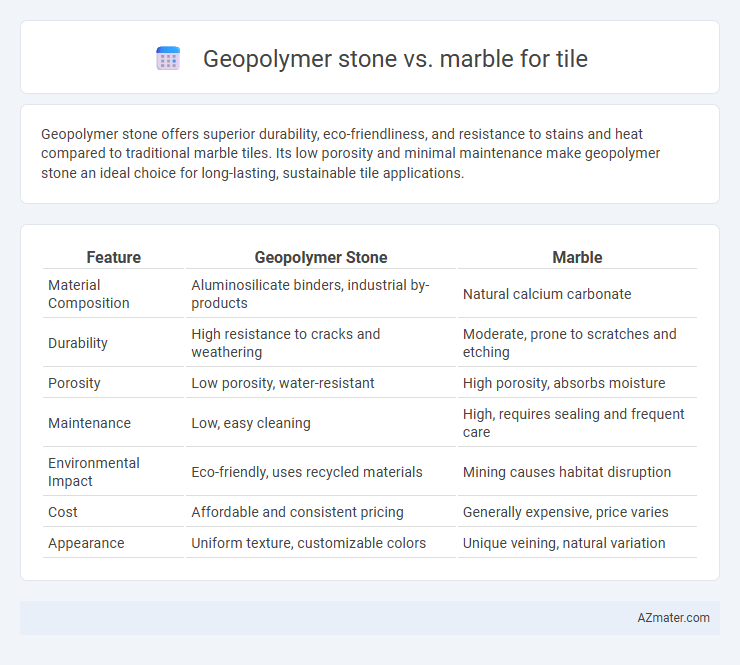Geopolymer stone offers superior durability, eco-friendliness, and resistance to stains and heat compared to traditional marble tiles. Its low porosity and minimal maintenance make geopolymer stone an ideal choice for long-lasting, sustainable tile applications.
Table of Comparison
| Feature | Geopolymer Stone | Marble |
|---|---|---|
| Material Composition | Aluminosilicate binders, industrial by-products | Natural calcium carbonate |
| Durability | High resistance to cracks and weathering | Moderate, prone to scratches and etching |
| Porosity | Low porosity, water-resistant | High porosity, absorbs moisture |
| Maintenance | Low, easy cleaning | High, requires sealing and frequent care |
| Environmental Impact | Eco-friendly, uses recycled materials | Mining causes habitat disruption |
| Cost | Affordable and consistent pricing | Generally expensive, price varies |
| Appearance | Uniform texture, customizable colors | Unique veining, natural variation |
Introduction: Understanding Geopolymer Stone and Marble
Geopolymer stone is an innovative, eco-friendly building material created by synthesizing industrial waste such as fly ash and slag, offering high durability and resistance to chemicals. Marble, a natural metamorphic rock primarily composed of calcite, has been cherished for centuries due to its luxurious appearance and unique veining patterns. Understanding the chemical composition and formation processes of both materials is essential for evaluating their suitability for tile applications in terms of strength, aesthetics, and maintenance.
Composition and Material Properties
Geopolymer stone consists primarily of aluminosilicate materials activated by alkaline solutions, resulting in a dense and durable composite ideal for tile applications. Marble is a natural carbonate rock composed mainly of calcite, known for its elegant veining but relatively softer and more porous structure compared to geopolymer stone. The superior chemical resistance, low porosity, and higher mechanical strength of geopolymer stone make it more resistant to staining and wear, whereas marble requires regular sealing to maintain its aesthetic and durability.
Sustainability and Environmental Impact
Geopolymer stone tiles offer significantly lower carbon emissions compared to traditional marble, as they utilize industrial waste materials like fly ash and slag, reducing landfill waste and the need for quarrying. The production of geopolymer stone consumes less energy and water, enhancing its sustainability by minimizing resource depletion and environmental degradation. In contrast, marble extraction and processing contribute to habitat destruction, water pollution, and higher greenhouse gas emissions, making geopolymer stone a more eco-friendly choice for sustainable tile applications.
Durability and Lifespan
Geopolymer stone offers superior durability compared to traditional marble tiles, exhibiting higher resistance to scratches, stains, and weathering due to its synthetic aluminosilicate composition. Unlike marble, which is prone to etching and requires regular sealing, geopolymer stone maintains structural integrity and aesthetic appeal over longer periods with minimal maintenance. The lifespan of geopolymer tiles often exceeds 50 years, outperforming marble that typically lasts 20-30 years in high-traffic applications.
Aesthetic Qualities and Design Versatility
Geopolymer stone offers a modern, customizable appearance with a wide range of colors and textures that can mimic natural stone or create unique, innovative designs, enhancing its appeal in contemporary spaces. Marble is prized for its classic, luxurious veining and natural elegance, providing timeless beauty and rich depth to interiors with each slab's unique pattern. Design versatility of geopolymer stone surpasses marble in terms of consistency and adaptability, allowing for precise shapes and finishes that suit various architectural styles and creative applications.
Cost Comparison and Affordability
Geopolymer stone offers a more cost-effective alternative to traditional marble tiles, with prices typically ranging 30-50% lower due to its synthetic composition and lower production costs. Marble tiles, known for their natural beauty, often incur higher expenses not only in material but also in installation and maintenance, which can significantly impact overall affordability. Budget-conscious projects benefit from geopolymer stone's durability and lower long-term expenses, making it a practical choice without sacrificing aesthetic appeal.
Installation Process and Maintenance Requirements
Geopolymer stone tiles offer a simplified installation process due to their lighter weight and uniform thickness compared to natural marble, reducing labor time and the need for specialized tools. Maintenance requirements for geopolymer tiles are minimal, as they resist stains, scratches, and moisture without frequent sealing, unlike marble which demands regular sealing and careful cleaning to prevent etching and discoloration. These factors make geopolymer stone an efficient and cost-effective alternative to marble for both residential and commercial flooring projects.
Performance in Different Environments
Geopolymer stone offers superior resistance to harsh chemicals, UV radiation, and freeze-thaw cycles compared to marble, making it ideal for both indoor and outdoor tile applications. Its low porosity and high compressive strength enhance durability in wet and cold environments where marble may deteriorate or stain. Unlike marble, which is prone to etching and requires regular sealing, geopolymer stone maintains structural integrity and aesthetic appeal with minimal maintenance in diverse climates.
Popular Applications in Tiling
Geopolymer stone offers superior durability and chemical resistance, making it popular for high-traffic commercial flooring and outdoor tiling where traditional marble might deteriorate. Marble remains favored in luxury residential interiors and bathrooms due to its elegant appearance and natural veining, despite its susceptibility to staining and scratching. Both materials find common use in wall cladding, but geopolymer stone's eco-friendly composition is increasingly chosen for sustainable building projects.
Choosing the Best Tile: Geopolymer Stone vs Marble
Geopolymer stone offers superior durability, high resistance to chemicals, and eco-friendly manufacturing compared to traditional marble, making it ideal for high-traffic tile applications. Marble provides timeless elegance with unique veining patterns and natural warmth but requires regular sealing and maintenance to prevent staining and etching. Choosing between geopolymer stone and marble depends on balancing long-term durability and sustainability against aesthetic preferences and maintenance commitments.

Infographic: Geopolymer stone vs Marble for Tile
 azmater.com
azmater.com